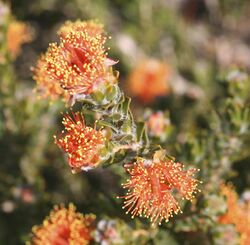Biology:Eremaea beaufortioides
| Eremaea beaufortioides | |
|---|---|

| |
| Scientific classification | |
| Kingdom: | Plantae |
| Clade: | Tracheophytes |
| Clade: | Angiosperms |
| Clade: | Eudicots |
| Clade: | Rosids |
| Order: | Myrtales |
| Family: | Myrtaceae |
| Genus: | Eremaea |
| Species: | E. beaufortioides
|
| Binomial name | |
| Eremaea beaufortioides Benth.[1]
| |
| Synonyms[1] | |
|
Melaleuca beaufortioides (Benth.) Craven & R.D.Edwards | |
Eremaea beaufortioides is a plant in the myrtle family, Myrtaceae and is endemic to the south-west of Western Australia. It is a spreading shrub with oval to egg-shaped leaves, and orange flowers in spring. Flowers appear in groups of one to six on the ends of long branches formed in the previous year.
Description
Eremaea beaufortioides is a spreading shrub growing to a height of 2.2 metres (7 ft). Its leaves are 2.9–5.6 millimetres (0.1–0.2 in) long, 1.4–4.2 millimetres (0.06–0.2 in) wide, flat, linear to broad egg-shaped and with up to 7 veins sometimes visible on the lower surface. There is variation in leaf size and shape between the three varieties of the species.[2][3]
The flowers are orange-coloured and arranged in groups of up to six on the ends of the branches of the previous year's growth. There are 5 sepals and 5 petals 3.5–5.7 millimetres (0.1–0.2 in) long. The stamens, which give the flower its colour, are arranged in 5 bundles, each containing 34 to 48 stamens. Flowering occurs from September to December and is followed by fruits which are woody capsules. The capsules are more or less barrel-shaped, smooth and 8–11 millimetres (0.3–0.4 in) long and 2.8–6.1 millimetres (0.1–0.2 in) wide.[2]
Taxonomy and naming
Eremaea beaufortioides was first formally described in 1867 by George Bentham in Flora Australiensis.[4][5] The specific epithet (beaufortioides) is presumably a reference to the similarity of this species to a species of Beaufortia since εἶδος (eîdos) is an Ancient Greek word meaning “form" or "likeness”.[2][6]
There are three varieties:[2]
- Eremaea beaufortioides var. beaufortioides has thin leaves with 5 or more veins and flowers with a glabrous hypanthium;[7]
- Eremaea beaufortioides var. lachnostanthe has thin leaves with 3 veins and flowers with a densely hairy hypanthium;[8]
- Eremaea beaufortioides var. microphylla has small, thick leaves with fewer than 3 veins which may be hard to see.[9]
Distribution and habitat
Eremaea beaufortioides is found in the Irwin district[2] in the Avon Wheatbelt, Geraldton Sandplains, Swan Coastal Plain and Yalgoo biogeographic regions.[3] It grows in sand over laterite.[10]
Conservation
Eremaea beaufortioides is classified as "not threatened" by the Western Australian Government Department of Parks and Wildlife.[3]
Use in horticulture
Eremaea beaufortioides is an attractive species but although it is the hardiest of its genus, is difficult to grow in more humid areas unless grafted. It needs a sunny position and excellent drainage.[11][12]
References
- ↑ 1.0 1.1 "Eremaea beaufortioides". Australian Plant Census. https://biodiversity.org.au/nsl/services/apc-format/display/89872.
- ↑ 2.0 2.1 2.2 2.3 2.4 Hnatiuk, Roger J. (1998). "A revision of the genus Eremaea (Myrtaceae)". Nuytsia 9 (2): 182–190. https://www.biodiversitylibrary.org/item/224642#page/52/mode/1up. Retrieved 2 November 2020.
- ↑ 3.0 3.1 3.2 "Eremaea atala". FloraBase. https://florabase.dpaw.wa.gov.au/browse/profile/13962. Retrieved 9 August 2015.
- ↑ "Eremaea beaufortioides". APNI. https://biodiversity.org.au/boa/instance/apni/511223. Retrieved 10 August 2015.
- ↑ Bentham, George (1867). Flora Australiensis (Volume 3). London: Lovell Reeve and Co.. p. 182. https://www.biodiversitylibrary.org/item/41807#page/190/mode/1up. Retrieved 10 August 2015.
- ↑ Brown, Roland Wilbur (1956). The Composition of Scientific Words. Washington, D.C.: Smithsonian Institution Press. p. 483.
- ↑ "Eremaea beaufortioides var. beaufortioides". FloraBase. https://florabase.dpaw.wa.gov.au/browse/profile/14098. Retrieved 10 August 2015.
- ↑ "Eremaea beaufortioides var. lachnostanthe". FloraBase. https://florabase.dpaw.wa.gov.au/browse/profile/14099. Retrieved 10 August 2015.
- ↑ "Eremaea beaufortioides var. microphylla". FloraBase. https://florabase.dpaw.wa.gov.au/browse/profile/14100. Retrieved 10 August 2015.
- ↑ Paczkowska, Grazyna; Chapman, Alex R. (2000). The Western Australian flora : a descriptive catalogue. Perth: Wildflower Society of Western Australia. p. 362. ISBN 0646402439.
- ↑ "Eremaea beaufortioides". Australian Native PlantsSociety Australia. http://anpsa.org.au/e-bea.html. Retrieved 10 August 2015.
- ↑ Wrigley, John W.; Fagg, Murray (1983). Australian native plants : a manual for their propagation, cultivation and use in landscaping (2nd ed.). Sydney: Collins. p. 212. ISBN 0002165759.
Wikidata ☰ Q15396896 entry
 |

